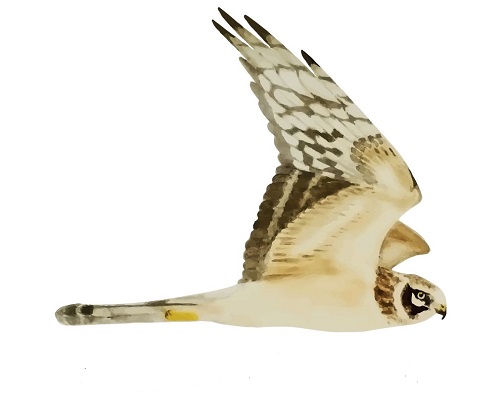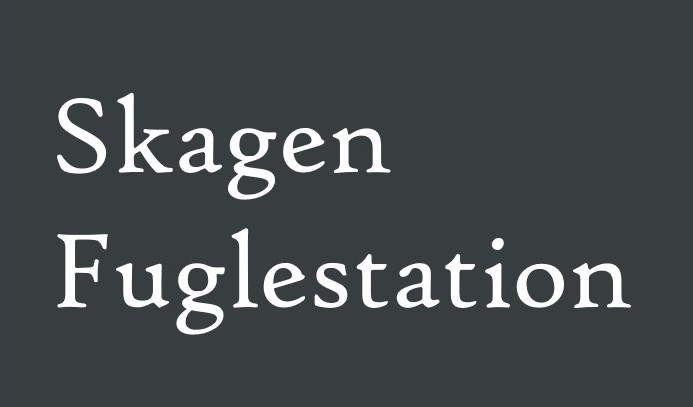Her på Skagen Fuglestations blog bringes korte nyheder i dagbogsformat om hændelser på fuglestationen.
Second attempt Nightjars
Today, Joakim and I woke up early to go ring in Grenen at 4:30.
We open the nets for four hours, it is not a morning with many catches, but we ringed some juveniles birds of the year, including the first Lesser white throat (1 C.y.), and some interesting recaptures.
Marie also woke up early this morning to go to the observation point in Grenen.
In the late morning we go back to the Observatory, and after having worked on the PC and lunch we decide to sleep a few hours in the afternoon, because we have planned to try again to catch nightjars tonight.
Simon has a meeting with Lene in the afternoon to plan the observatory's future activities.
Later our dear guests Anne and Jesper prepared a delicious fish dinner for us!
Immediately after dinner we get together to plan the activities for the following days, and review the details for tonight, after which we prepare all the equipment to catch the nightjars.
We leave after a few hours, at 9.30 pm, and after half an hour by car and ten minutes walk we are on the spot.
We assemble the nets carefully but quickly and position the calls.
Now we just have to wait, and hope that some nightjar goes into the nets ...
Ringing (Sardinkrattet):
-Kærsanger 1
-Grønsisken 1
-Munk 3
-Tornsanger 3
-Gærdesanger 3
-Havesanger 1
Tot.: 12
People: Marie Heuberger, Michele Pes, Joakim Matthiesen, Simon S Christiansen, Anne and Jesper Sandfeld.
Mange sommerfugle
Vi er gæster I Det grå Fyr i denne uge og følger interesseret med i, hvad stedets fuglefolk foretager sig. De vil gerne fortælle – og vi lytter.
Den første, der var oppe og af sted i dag, var Marie, der cyklede mod Grenen kl. 5.20.Hun så bl.a. Storspove og Hvepsevåge og brugte resten af dagen på kontorarbejde. Michele sov længe og havde forskellige pligter, både faglige og huslige. Joakim skrev sjældenhedsrapport for Lille Rørsanger, bl.a. Sammen cyklede de 3 om eftermiddagen til Grenen for at se den indrapporterede Snespurv – i sommerdragt! De havde dog ikke held med at se den. Simon havde dagen optaget af møder, men havde dog tid til at observere en Rødrygget Tornskade ved Højen Fyr.
En af dagens Tornsangere
Vi foretog nogle gode vandreture i Skagen Klitplantage efter at have hentet vandrekort på Turistbureauet. Vi så og hørte de forventelige fugle, især mange Tornsangere. Til tider spadserede vi i en sky af Tidselsommerfugle, som havde selskab af Plettet Ildfugl, Blåfugl og diverse Bredpander. Især Tidselsommerfuglene var glade for at sidde på den varme grusvej.
Folk: Marie Heuberger, Michele Pes, Joakim Matthiesen, Simon S Christiansen, Anne og Jesper Sandfeld
Dagen derpå
Humøret er højt og vi er stadigvæk alle ovenpå efter den lille rørsanger i går! Det er stadigvæk dagens emne når snakken går over morgenkaffen eller aftenbordet! Det tager nok lige lidt tid at få det ud kroppen, men det er helt ok.
I dag satte vi igen nettene op i Sardinkrattet. Vinden var næsten ikke ekstisterende, men det samme var fuglene. Det var en stille morgen, men dog en flot og rolig en af slagsen. Vores nye gæster kom forbi og så hvordan ringmmærkningen går til. De var meget interreserede og fik lært en masse. Så det var faktisk en rigtig god morgen selvom det ikke væltede med fugle i nettene. Det var Michelé og jeg som ringmærkede i dag.
Marie har længe ønsket at tage til Råbjerg Mile. Det var der tid til i dag. Så hun sov lidt længere end os andre i dag og stod op kl.8. Herefter cyklede hun hele vejen til Råbjerg Mile og tilbage igen. En lang tur, men hun synes bestemt, at det var det hele vær.
Enormt stjerneskud serveret med øl til. Tak Flemming!

Simon er endelig sådan rigtigt tilabge på stationen igen efter en uge i København og en weekend sammen med vennerne. Han startede hårdt ud i dag med et bestyrelsesmøde. Det varede i 6 timer!!!!!!! , men det er åbenbart meget normalt. Det lød dog til at det være gået godt og at de havde nået et hel masse.
Michelé og jeg nød godt af bestyrelsesmødet. Der var nemlig meget mad i overskud. Så vi fik os et KÆMPE stjerneskud til frokost. Det var vildt lækkert og sød som han er, kom Flemming lige med et par øl til os også. Mange tak for det! En helt perfekt frokost ude i solen ved Det Grå Fyr. Det tog os 1 1/2 time at komme igennem det hele.
Ringmærkning Grenen:
Topmejse - 2
Rørsanger - 1
Munk - 2
Tornsanger - 1
Total: 6
Folk: Marie Heuberger, Michele Pes, Joakim Matthiesen, Simon S Christiansen, A+J.
Lille Rørsanger!
This morning I Joakim and Marie woke up at 3:00 and went to Sardinkrattet to open the nets.
The morning is quite hot and windless, in the first few rounds we captured a few birds, but around 6:00 am we catched and ringed a special bird, a Lille Rørsanger (Acrocephalus agricola)!
We are all very excited, it is a very rare bird! Simon joins us in a short time to release the bird, before showing it to some birders present in Grenen, who have come to see the rarity.
This birds ends up the spring-season in a verry good way. This is by far the rarest bird we have caught this year!!!! Its only the 14. time that the bird is ever seen i Denmark. Its the 7. time it is seen in Skagen. So Skagen is a verry good place for lille rørsanger. However still a really rare bird, even up here! We were all so happy and it will take a long time to get over this experience! So cool!


...
Later at 11:00, Joakim and Marie are busy with a guided tour, they have to accompany Danish and American tourists on a birding tour around the Grenen area.
I decide to go to the beach to the north to try to find and observe some laid seagulls.
Along the way, I find several pairs and nests of Ringed plover, one with three eggs, one empty.
In this period the situation is not easy for them, because the incubation period coincides with the beginning of the tourist season and the numerous presence of people on the beaches. So many tourists walking, dogs, tractors with tourists, tours with horses on the beach, etc., all activities that if carried out in massive doses every day greatly increase the risk of disturbance and consequent losses of broods for couriers, reproductive success does not it is not insured at all.

A little further away I find a great group of seagulls that stop at the beach. There are so many Great black-backed gull, Herring gull and Lesser black-backed gull, many with colored rings that I can read.

Ring readings are very interesting data, in fact we can go back to the individual history of the life of each ringed individual, discover their movements and other important information.
After a few hours I return to the Observatory at around 17:00. Shortly after we welcome our new guests who will stay with us next week.
Tonight there will be a special beach party with a big fire and a witch, which coincides with the summer solstice.
We decide to go out and enjoy the evening with some beer to celebrate the super day of Lille Rorsanger !!!


Ringing (Sardinkrattet):
-Lille rørsanger 1
-Rørsanger 2
-Grønsisken 3
-Tornsanger 2
-Munk 1
-Gulbug 1
Tot: 10
People: Marie Heuberger, Michele Pes, Joakim Matthiesen, Simon S Christiansen, A+J.
Landsvale in the addict!
This windy morning Michele and Joakim slept a bit longer, because it was to windy to ring, but they opend the nets at Fyrhaven, for a guided ringing tour. I went out observing to Grenen, where Rolf joined me for a short time, but most of the time, I was sitting alone – first time ever that this happened! But I enjoyed watching some Sule diving in the icy waves for fish. At this time of the year, most of them are already gone, so it’s always a pleasure, when we see some late guests!
The day started quite normal, but when Joakim walked pass the lab, he heard some weird noises. Was there a bird in the lab? But no one was ringing, the nets in the garden where already closed. So he went in to have look and surprise: Two Landsvale at the addict! With Micheles help he caught both of them and we could ring them! It was one male and one female, so it was couple! After ringing them we released them together in the garden. What fascinating birds!

Ringing (Fyrhaven):
Landsvale 2
Sum: 2
Folk: Folk: Marie Heuberger, Marianne, Michele Pes, Joakim Matthiesen, Simon S Christiansen
Stille dag
Dagens dagbog bliver kort, for ja, der skete ikke meget i dag.
Dagens højdepunkt var natravnefangsten som sluttede kl 04:00 om morgenen, men den har Michele allerede nævnt i det tidligere indlæg. Det blev desværre ikke til nogen natravne denne gang, men vi fik set en hel masse som fløj rundt i området! Så det var altså en god oplevelse alligevel. Natravnen er godt nok en underlig fætter, men man bliver altid glad når det lykkedes at få den at se. Og det gjorde vi i den grad. I de 5 timer vi brugte i skoven så og hørte vi i hvert fald 6-8 fugle og nok endnu flere. Flere gange fløj de rundt og fangede insekter på kun få meters afstand fra hvor vi sad og vnetede! Fed oplevelse!
Dagen derpå var stille da vi alle sov længe. Vi åbnede nettene i fyrhaven kl 12:00 da en journalist gerne ville filme noget ringmærkning. Vejrforholdene var dog ikke helt optimale og det lykkedes derfor ikke at fange nogle fugle.
Her et billede fra sidste år hvor det lykkedes at fange en natravn! Det skal nok også lykkes i år, vi har slet ikke givet op endnu!

Herudover skete der ikke rigtigt noget. Vi fik hver især klaret lidt småopgaver, men ellers var dagen sådanset til fri 'fortolkning' så det blev til lidt gåture i området, aflsapning, og ellers ikke meget mere. Men sådan skal det også være nogle gange!
Folk: Marie Heuberger, Marianne, Michele Pes, Joakim Matthiesen
Night of Nightjar
Today we are planning a tour guide with a primary school class, so we open the nets in the garden at 08:00 am.
We explain to children about our activities at the Bird Observatory and we try to make them aware of the impact of plastic pollution on birds and marine and terrestrial habitats.
Tonight we will go south of Skagen, to a place where many pairs of Nightjar are concentrated, to try to ring them.
So in the afternoon we prepare all the equipment we will need for the night, and afterwards we sleep for a few hours because we will have to stay up all night.
At 10:00 pm, Jørgen Kabel og Frede Jakobsen will arrive and accompany us kindly with their cars. We start from the observatory, and after about half an hour by car and ten minutes on foot we arrive on the spot.
We observe severals Nightjar in the area, they hope to catch some, but it is not easy.
At 11.15 pm all the nets are already in place, we just have to wait ...
Folk: Marie Heuberger, Marianne, Michele Pes, Joakim Matthiesen
A mistical morning at Verdens Ende
This morning in the field was really foggy and it was hard to spot any birds. But the mood was mystical and I used the time to draw a Lærkefalk. After nearly two months of watching and observing birds, my falcons finally don’t look like gulls anymore! While I drawed, the Rørdrummer boomed in the reeds and a Karmindompap let hear his tropical call. During a walk to the tip, I spotted a lot of Stor Præstekrave, sneaking secretly around the beach. I still wonder, where their chicks are and hope, we are just not smart enough to find them, and not, that they haven’t hatched any.
Joakim and Michele were ringing meanwhile, but we all had to get back to the obs early, because we had two guided tours with school classes. They were quite interest and it was a pleasure to educate the next generation about ringing and birds in general. Maybe one of them will work as a volunteer at the obs in the future?
The first weeks, when I came here, I was more interested in ringing and I learnt a lot about moult in this time. But since a few weeks, I’m more up to observing and migration counting. Even though the main migration time is already over, there is still a lot going on and it’s fascinating to watch it. The Sule, which were so common when I came, have nearly completely left, but there are so many Grønsisken and Stær these days! The high “tiluuuh” of the Grønsisken can be heard from far away and when you finally see them, it’s hard to count them, as they bounce around like rubber balls. Counting the Stær is a little more easy. But you have to watch closely, maybe there’s a Rosenstær in between them? And a few late guests are still around, like this Kvækerfinke, hanging around Grenen for a few days already. I wonder if he will still make it, to his final destination? And slowly the first autumn migrants arrive, like male eiders, who leave the breeding site earlier than the female.
And a short spoiler for tomorrow: We will be catching NATRAVN tomorrow night! So stay tuned, we will update you on Facebook!!

Ringing (Sardinkrattet + Fyrhaven):
Rødhals 1
Kærsanger 2
Rørsanger 4
Tornsanger 7
Sum: 14
P.S.: I have only ten days left here at the obs :( Unbelievable how fast time flies!
Folk: Marie Heuberger, Marianne, Michele Pes, Joakim Matthiesen
Rundvisningsdag! / guidet-tur-dag
Vejrudsigten lovede regn om morgenen. Den holdte stik, selvom der da ikke kom så meget som de havde lovet. Det var dog nok til, at vi ikke åbnede nettene, hvilket passede mig meget godt netop denne dag da jeg lige er kommet tilbage på stationen efter, at have været hjemme i 5 dages tid. Det tager trods alt lidt tid at komme fra Køge til Skagen med offentlig transport.... nærmere sagt faktisk 9 timer. Selvom man bare sidder stille i bus eller tog så tager det faktisk ret meget energi at rejse så langt af en eller anden grund?
Så da vi vågnede omkring kl 08 var vi alle friske og veloplagte til dagens aktiviteter. I dag kom der nemlig to skoleklasser, som er på lejrtur i Skagen. De kom for at høre om liver som frivillig på stationen og lærte hvordan og hvorfor vi ringmærker fugle. Derudover havde jeg forberedt et lille oplæg om plastik-forurening og pesticiders betydning for fuglene. Eleverne har nemlig lige haft om pesticider i skolen, så det var fint at de kunne bruge det lidt i 'virkeligheden'.'

Skoleklasse på tur ved nettene i den gamle fyrhave. Selvom der var mange myg overlevede de alle sammen!
Begge ture gik fint og vi havde et par fugle til begge hold, som de kunne se blive ringmærket. Nu glæder vi os til i morgen hvor ydeligere to skoleklasser kommer og får samme tur som vi har givet i dag.
Resten af dagen var stille og rolig og jeg fik lavet en omgang svensk pølseret til aftensmad.
Ringmærkning (Fyrhaven):
Munk - 1
Tornsanger - 2
Total - 3
Folk: Marie Heuberger, Michele Pes, Joakim Mattiensen, Marianne.
Summer day
Today I woke up at 3:00 to go to ringing at Sardinkrattet.
At 4:00 all the nets were open, a day of good weather and little wind, I was confident that it would be a good day.
Marie also woke up early and went to Grenen for observations.
The morning was very good with a pleasant climate, several species ringed and many recaptures.




At 11:00 I closed the nets and returned to the observatory.
In the afternoon Marianne arrived, she is a new guest for this week.
Marie welcomes the visitors, who now become more numerous as the season has begun.
I update today's data on the databases and after spending a dinner tonight.
Joakim returns tonight, who has been at home for a few days. We look forward to having dinner together.
Ringing (Sardinkrattet):
-Munk 4
-Rørsanger 3
-kærsanger 1
-Grønsisken 1
-Gærdesanger 2
-Topmejse 1
- Gærdesmutte 1
- Bogfinke 1
- Gransanger 1
Tot: 15
People: Marie Heuberger, Michele Pes, Joakim Mattiensen, Marianne






